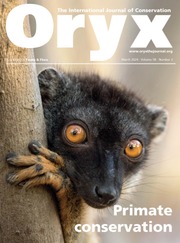Crossref Citations
This article has been cited by the following publications. This list is generated based on data provided by
Crossref.
Decher, Jan
1997.
Conservation, Small Mammals, and the Future of Sacred Groves in West Africa.
Biodiversity & Conservation,
Vol. 6,
Issue. 7,
p.
1007.
Colding, Johan
and
Folke, Carl
2001.
SOCIAL TABOOS: “INVISIBLE” SYSTEMS OF LOCAL RESOURCE MANAGEMENT AND BIOLOGICAL CONSERVATION.
Ecological Applications,
Vol. 11,
Issue. 2,
p.
584.
Campbell, Michael O’Neal
2005.
The ecological and social context of mammal hunting in the coastal savanna of Ghana.
Geoforum,
Vol. 36,
Issue. 6,
p.
667.
Saj, Tania L.
Mather, Charles
and
Sicotte, Pascale
2006.
Traditional taboos in biological conservation: the case of Colobus vellerosus at the Boabeng-Fiema Monkey Sanctuary, Central Ghana.
Social Science Information,
Vol. 45,
Issue. 2,
p.
285.
Wong, Sarah N. P.
Saj, Tania L.
and
Sicotte, Pascale
2006.
Comparison of habitat quality and diet of Colobus vellerosus in forest fragments in Ghana.
Primates,
Vol. 47,
Issue. 4,
p.
365.
Saj, T. L.
and
Sicotte, P.
2007.
Predicting the Competitive Regime of Female Colobus vellerosus from the Distribution of Food Resources.
International Journal of Primatology,
Vol. 28,
Issue. 2,
p.
315.
Sicotte, Pascale
Teichroeb, Julie A.
and
Saj, Tania L.
2007.
Aspects of Male Competition in Colobus vellerosus: Preliminary Data on Male and Female Loud Calling, and Infant Deaths After a Takeover.
International Journal of Primatology,
Vol. 28,
Issue. 3,
p.
627.
MacIntosh, Andrew J.J.
and
Sicotte, Pascale
2009.
Vigilance in ursine black and white colobus monkeys (Colobus vellerosus): an examination of the effects of conspecific threat and predation.
American Journal of Primatology,
Vol. 71,
Issue. 11,
p.
919.
ORMSBY, ALISON A.
and
BHAGWAT, SHONIL A.
2010.
Sacred forests of India: a strong tradition of community-based natural resource management.
Environmental Conservation,
Vol. 37,
Issue. 3,
p.
320.
Hill, Catherine M.
and
Webber, Amanda D.
2010.
Perceptions of nonhuman primates in human–wildlife conflict scenarios.
American Journal of Primatology,
Vol. 72,
Issue. 10,
p.
919.
Riley, Erin P.
2010.
The importance of human–macaque folklore for conservation in Lore Lindu National Park, Sulawesi, Indonesia.
Oryx,
Vol. 44,
Issue. 2,
p.
235.
Gwali, Samson
Okullo, John Bosco Lamoris
Eilu, Gerald
Nakabonge, Grace
Nyeko, Philip
and
Vuzi, Peter
2012.
Traditional management and conservation of shea trees (Vitellaria paradoxa subspecies nilotica) in Uganda.
Environment, Development and Sustainability,
Vol. 14,
Issue. 3,
p.
347.
Ormsby, Alison
2012.
Sacred Species and Sites.
p.
335.
Wikberg, Eva C.
Sicotte, Pascale
Campos, Fernando A.
Ting, Nelson
and
Lambert, Joanna E.
2012.
Between-Group Variation in Female Dispersal, Kin Composition of Groups, and Proximity Patterns in a Black-and-White Colobus Monkey (Colobus vellerosus).
PLoS ONE,
Vol. 7,
Issue. 11,
p.
e48740.
Sarfo-Mensah, Paul
Owusu-Bi, Akwasi
Awuah-Nyamekye, Samuel
and
Amisah, Steve
2014.
Environmental Conservation and Preservation of Cultural Heritage.
Worldviews,
Vol. 18,
Issue. 1,
p.
30.
Osei-Tutu, Paul
Pregernig, Michael
and
Pokorny, Benno
2014.
Legitimacy of informal institutions in contemporary local forest management: insights from Ghana.
Biodiversity and Conservation,
Vol. 23,
Issue. 14,
p.
3587.
Nijman, V
and
Nekaris, KAI
2014.
Traditions, taboos and trade in slow lorises in Sundanese communities in southern Java, Indonesia.
Endangered Species Research,
Vol. 25,
Issue. 1,
p.
79.
Osei-Tutu, Paul
Pregernig, Michael
and
Pokorny, Benno
2015.
Interactions between formal and informal institutions in community, private and state forest contexts in Ghana.
Forest Policy and Economics,
Vol. 54,
Issue. ,
p.
26.
Angsongna, Alexander
Ato Armah, Frederick
Boamah, Sheila
Hambati, Herbert
Luginaah, Isaac
Chuenpagdee, Ratana
and
Campbell, Gwyn
2016.
A systematic review of resource habitat taboos and human health outcomes in the context of global environmental change.
Global Bioethics,
Vol. 27,
Issue. 2-4,
p.
91.
Papworth, Sarah
2016.
Ethnoprimatology.
p.
95.

